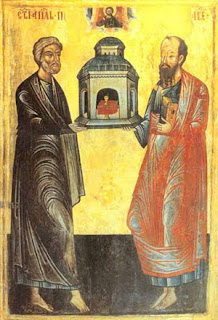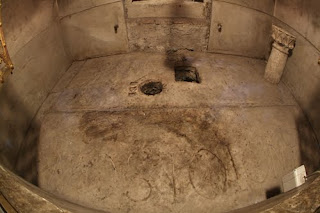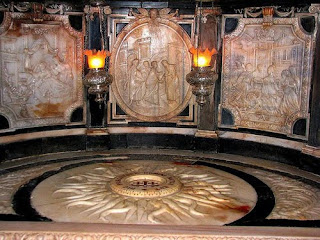
Saint Paul, well known as the Apostle of the Nations, or “Apostle to the Gentiles” (Romans 11,13, Galatians 2,8, 1 Timothy 2,7), has been almost all the time associated with the other big Apostle of the Church, Saint Peter. Except the period that both lived and preached in Rome, about the period of Nero’s reign as emperor, there’s possible that both met only twice in their lives and there may possible, that they hadn’t quite the same ideas about preaching the Gospel among the nations. But until coming to the point about the ideas and the mission of St. Paul, there’s also important to mention that he is the most important writer of the New Testament. If we try to calculate statistically, Paul wrote about one third of the whole canonical corpus of the New Testament, being followed by St. Luke with about one fifth, and the Saints John the Evangelist and Matthew, with some around one tenth each. Of course, the statistics are not very appropriate concerning the Bible, but they may show us about how much important is the teachings of St. Paul for our Church.
There is also to mention the fact that, according to the new scholar researches, St. Paul would be the first to mention about the Last Supper and the words of Our Lord about the bread and the wine as His Holy Body and Holy Blood, in 1 Corinthians 11,23-26.
Paul’s Biography
The main source for historical informations about Saint Paul’s life is the material found in several of his epistles, such as Galatians and Romans and the Book of Acts, written by St. Luke, who may have been a mission-comrade to Paul. Even if the Book of Acts is after its twelfth chapter no more an Acta Apostolorum, but either an Acta Pauli, that writing tells us nothing about the Paul’s life after arriving Rome, or about his supposedly martyrical death.
As there is known, St. Paul is born in Tarsus, the capital city of Cilicia, in the southern Turkey today. Being a roman citizen and a scholar in the Rabbinical School of Gamaliel, we may imagine that he would be born in a rich family, of tent-makers, a trade that Paul practiced in order to support himself throughout his ministry. At his time, only a few people in the East had the privilege of being Roman citizens. This quality helped Paul a lot in his mission and later escaping him from the furious people from Jerusalem, who wanted him dead. On the other side, being “of the stock of Israel, of the tribe of Benjamin, an Hebrew of the Hebrews; as to the law, a Pharisee”(Philippians 3,5, but also at Acts 23:6), and a scholar “at the feet of Gamaliel”, it means that he was a very good knower of the Hebrew Law, that being obvious also from his teaching in the Epistles. On the other side, there’s known that Gamaliel gave an advice at the rabbinical council in Acts 5:34-39, to “refrain” from slaying the disciples. That may be interpreted that his teaching was not a fundamentalist one, being somehow in contrast to the rashness of his student Saul, who went on a rampage, after the death of Stephen, persecuting the “saints”.(Acts 9:13; Acts 26:10)
His original name Saul, in Hebrew Shaul, means “asked for, prayed for”, and was a regular name towards Israel. The usage of the name Paul comes first after his conversion, when he begins his first missionary journey into a new territory.
Paul as an Apostle
Before his conversion, Paul may have been living in Jerusalem in the times when Jesus was convicted and crucified. Anyway surely he was among the ones who convicted St. Stephen to death, even if himself didn’t stoned him, but he just guarded the clothes of the ones who killed the first martyr (Acts 7,58 and 8,1). Paul himself confesses in the first chapter of the Epistle to the Galatians that he persecuted the church of God “beyond measure”, prior to his conversion. So his activity was a strong struggle against the ones who confessed that Jesus is Messiah. But even like that, the episode of his conversion makes us to believe that his “persecution” was not only a fight against, but also a personal searching of the Truth. Also his fury and his ambitious character, first exercised against the Church, provd to be changed by Our Lord into good qualities for preaching His Gospel.

On the way to Damascus, where he was sent to imprison the Christians, Paul has a vision and Jesus Himself shows himself to him as a thunder of light (Acts 9,3). Paul hears a voice saying: “Saul, Saul, why are you persecuting me?” (9,4). There is important to mention, that the Latin word persequeris is noted in the Greek version with “διώκεις”. The verb διώκω means in the first understanding, to run swiftly in order to catch a person or thing, to run after someone, but metaphorically means to pursue, to seek after something eagerly. So the Words of our Lord may be understand also as “why are you running after me?”, discovering even to Saul himself that his struggle was in fact a running not against, but on finding Something, the Truth, the true Messiah.
Paul’s conversion can be dated to the years 31 – 36, by the reference to his letters. After being temporarily blinded and cured by Ananias, an apostle in Damascus, Paul may have lived there for a while. Shortly he left in Arabia (Gal. 1,17), which was commented either as the Nabataean Kingdom, or symbolically as Mount Sinai, the mount of the visions. Here went to seek God both Moses and Eliah, the very ones who appear in the Transfiguration episode in the Gospels. There’s possible that here occurred the famous ascension of Paul until the third Heaven, that he mentions in 2 Cor.12,2-5. Also Paul mentions that he went back in Damascus and only three years later he met the Apostles. This information is important, because that says partly, that Paul didn’t take his Apostolate through the Preaching of the 12 Disciples of the Lord but from the Lord Himself (Gal. 1,12), and also, because there should be pass some years, so that the Apostles believe him that he is no more a simple Pharisee, a persecutor, neither a kind of traitor infiltrated inside the Church, but the very Apostle of Christ.
The missionary Journeys

In the same epistle to Galatians, Paul states that he met Peter and stayed together with him for 15 days and he met also St. Jacob, the Lord’s Brother (Gal 1,18-19). Shortly after, he went to Antioch, where the followers of Jesus were first called Christians. From there Paul started together with Barnabas his first missionary journey among the people from Cyprus, Asia Minor, and Greece, which accomplished with a great success, founding new communities in Iconium, Listra and Derbe. Shortly after his coming back in Antioch, the success of his mission had echoes, but the methods applied by Paul, without obliging the new Christians to respect the Jewish Law and customs, such as the circumcision, were quite strange to understand and to accept by the Palestinian community. So it happened the Apostolical Synod in Jerusalem, around the year 50. The decisions taken here were the ones applied already by Paul. The Christians are not obliged to respect the Jewish customs, if they were pagans before, but they must some minimal rules. Paul’s genius was obvious. In his epistles there’s quite clear that he respects the Jewish Law in which concerns its morality, but he refuses to accept the traditions and rituals, as unnatural for the New People of God. In this direction, the old and the new Christians, even if they differ in customs, language, traditions, they are the same: “There is neither Jew nor Greek, there is neither slave nor free man, there is neither male nor female; for you are all one in Christ Jesus” (Galatians 3,28).

Even if the Council accepted the conversion of the non-Jews, Paul seems to have had a conflict with Peter. There is true, that Peter was an authority in the Church, but Paul doesn’t shy to attention him when he was wrong: being among the Christians in Antioch, Peter didn’t want to take the meal with the one not circumcised. Paul states that “when I saw that they walked not uprightly according to the truth of the gospel I said unto Peter before them all: If thou being a Jew livest after the manner of Gentiles and not as do the Jews why compellest thou the Gentiles to live as do the Jews?” (Gal. 2,15). This verse shows that Paul became an authority in the Church such as Peter or James or another among the Apostles.
Second missionary journey
Paul leaves from Jerusalem for his second missionary journey, in the autumn after the Council of the Apostles. On their trip, Paul and Barnabas decided to separate, Barnabas taking John Mark with him, while Paul takes Silas. They travel to Tarsus, Derbe and Lystra. Here they meet Timothy, and later go to the western shore of the Lesser Asia. In Troy there’s possible they have taken St. Luke, because after this moment, the Evangelist refers as to the second person plural. Further, they go in Europe. At Philippi, Paul and Silas are put in jail, but after a miraculous earthquake, the gates of the prison fall apart and Paul and Silas are able to escape; this event led to the conversion of the jailor. They continued traveling, went by Berea and Athens where Paul preached to the Jews and Greeks in the Areopague about the “unknown God”, a masterpiece in the technic of oratory. In Corinth, Paul met Aquila and Priscilla who became faithful believers and helped Paul through his other missionary journeys. The couple followed Paul and his companions to Ephesus, and stayed there to start one of the strongest and most faithful Church at that time. In 52, the missionaries sailed to Caesarea to greet the Church there, and traveled down to Antioch to stay there for about one year before leaving again on their third missionary journey.
Third missionary journey
Paul began his third missionary journey by traveling all around the region of Galatia and Phrygia to strengthen, teach and rebuke the believers. When he arrived in Ephesus, he stayed there for a little less than 3 years and performed a lot of miracles, like healing people and casting out demons. Then he went through Macedonia, Greece, and as he was getting ready to leave for Syria, he changed his plans because of the Jews who had planned a plot against him, and had to go back through Macedonia. He finished his trip in Caesarea, intending to go back in Jerusalem, in order to help the community here with supplies.
Journey to Rome and the Martyrdom
In Jerusalem, the community there received him joyfully, but being in the temple for a prayer, Paul is recognized and beaten almost to death before being arrested by the Romans. That was his salvation, because he was a Roman citizen. Being kept as a prisoner in Caesarea for about one year and a half, he was transferred to Rome after his request and was released after the Roman commander realized that he was born a Roman citizen. Paul and his companions went on to Rome, which was probably their last missionary journey, in 60.
In this moment stops all the biblical informations about the Apostle. According to the traditions, Paul continued to preach in Rome and possibly traveled to other countries like Spain and Britain before he died as a martyr, probably also in Rome by beheading. This event has been dated either to the year 64, when Rome was devastated by a fire, or a few years later, in 67. Being a Roman citizen, he wasn’t tortured such as other Christians, and he wasn’t crucified as St. Peter. The tradition states that he might be executed in the same day with St. Peter, on 29th of June, during the persecutions ordered by the Emperor Nero. The early liturgical solemnity of Peter and Paul, celebrated on June 29, may reflect the day of their martyrdom.
The intense activity of St. Paul is beautifully described by himself. It was a successful one, but not without troubles, beatings and other dangers. He says about himself that:
“… Are they ministers of Christ? I speak as a fool: I am more in labours more abundant in stripes above measure in prisons more frequent in deaths oft; Of the Jews five times received I forty stripes save one; Thrice was I beaten with rods once was I stoned thrice I suffered shipwreck a night and a day I have been in the deep; In journeyings often in perils of waters in perils of robbers in perils by mine own countrymen in perils by the heathen in perils in the city in perils in the wilderness in perils in the sea in perils among false brethren; In weariness and painfulness in watchings often in hunger and thirst in fastings often in cold and nakedness. Beside those things that are without that which cometh upon me daily the care of all the churches. Who is weak and I am not weak who is offended and I burn not. If I must needs glory I will glory of the things which concern mine infirmities. The God and Father of our Lord Jesus Christ which is blessed for evermore knoweth that I lie not...” (2 Cor. 11,23-30).
Veneration
Fourteen epistles in the New Testament are attributed to Paul, those being to the Romans, two to the Corinthians, to Gallatians, to Efessians, to Philippians, to Collosenes, two to the Thesalonicenes, two to his disciple Timothy, one to Titus, one to Philemon and one to the Hebrews. The importance of his epistles is unmeasurable and speaking about them, on may write entire libraries without finishing.
The Grave of St. Paul was, according to the tradition, under the altar of The San Paolo alle Tre Fontane church in Rome. Another tradition holds that Paul was interred with Saint Peter at Catacombs by the via Appia until moved to what is now the Basilica of Saint Paul Outside the Walls in Rome. St. Bede, in his Ecclesiastical History, writes that Pope Vitalian in 665 gave Paul’s relics (including a cross made from his prison chains) from the crypts of Lucina to the King Oswy of Northumbria, from northern Britain. However, Bede's use of the word “relic” was not limited to corporal remains.

In June 2009, Pope Benedict XVI announced the excavation results concerning the tomb of Paul at the Basilica of Saint Paul Outside the Walls. The sarcophagus itself was not opened, but was examined by means of a probe. It revealed pieces of incense and purple and blue linen as well as small bone fragments. The bone was radiocarbon dated to the 1st to 2nd century. According to the Vatican, this seemed to confirm the tradition of the tomb being Paul's.
Saint Paul is the patron saint of London and of another many cities and Christian Communities around the World. He is almost always celebrated together with St. Peter and millions of Christians bear his name.
Saint Paul is the author of the most beautiful hymn ever dedicated to love, which is to be found in the 1 Corinthians, chapter 13:
“If with the tongues of men and of messengers I speak, and have not love, I have become brass sounding, or a cymbal tinkling; and if I have prophecy, and know all the secrets, and all the knowledge, and if I have all the faith, so as to remove mountains, and have not love, I am nothing; and if I give away to feed others all my goods, and if I give up my body that I may be burned, and have not love, I am profited nothing. The love is long-suffering, it is kind, the love doth not envy, the love doth not vaunt itself, is not puffed up, doth not act unseemly, doth not seek its own things, is not provoked, doth not impute evil, rejoiceth not over the unrighteousness, and rejoiceth with the truth; all things it beareth, all it believeth, all it hopeth, all it endureth. The love doth never fail; and whether there be prophecies, they shall become useless; whether tongues, they shall cease; whether knowledge, it shall become useless…”
Troparion of St. Apostles Peter and Paul:
“First-enthroned of the apostles, teachers of the universe: Entreat the Master of all to grant peace to the world, and to our souls great mercy!”














